
The African
Consumer
and Retail
Sector Report
kpmg.com/africa

Table of contents
Overview 1
Key Drivers 2
Demographics 2
Macroeconomic Environment 3
Impact of Lower Oil Prices 7
Incomes and Spending Patterns 8
Consumer Traits 12
Challenges 13
Retail Markets in a Selection of Key African Economies 15
Egypt 17
Ghana 18
Kenya 19
Morocco 20
Nigeria 21
Sources of Information 24
Contact Details 25
The series has the following reports:
• Banking in Africa
• Private Equity in Africa
• Insurance in Africa
• Power in Africa
• Healthcare in Africa
• Oil and Gas in Africa
• Construction in Africa
• Manufacturing in Africa
• Fast-Moving Consumer Goods in Africa
• Luxury Goods in Africa
• White Goods in Africa
• Agriculture in Africa
• Life Sciences in Africa
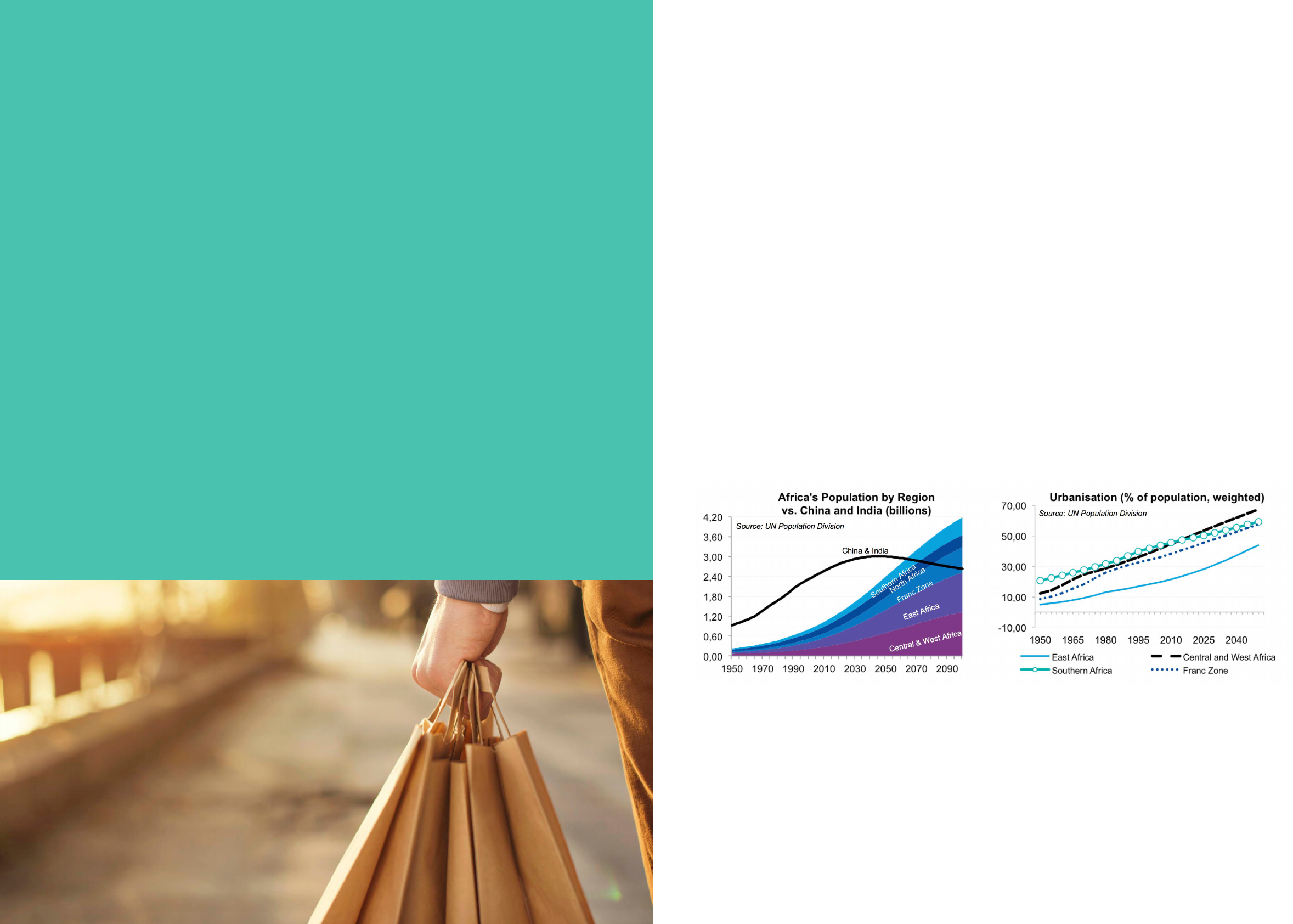
1 | The African Consumer and Retail The African Consumer and Retail | 2
Africa is home to more than one billion people, presenting a
massive potential consumer market. Moreover, population
growth remains rapid, and the United Nations (UN) Population
Division forecasts that the continent’s population will surpass
the 1.5 billion mark by 2026 and the two billion mark 15 years
later. In addition, Africans are increasingly moving to cities,
making it easier for companies to target certain consumer
groups. Although the demographic make-up of the continent
is extremely favourable, success is not guaranteed. Firstly,
there are vast differences across countries – North Africa
is for example far more developed than sub-Saharan Africa
(SSA), while the retail market opportunities in countries
will differ due to variances in consumer tastes, culture,
income, and demographics. Secondly, it is important to
distinguish between opportunities at the national and at the
city level. Data at the national level can often be misleading,
as a city’s GDP per capita can vastly exceed the national
average due to the greater concentration of wealth in
some urban areas. Finally, simply because a country has
favourable demographics does not mean that this will
necessarily translate into higher levels of economic growth
and consumer spending. An increase in the proportion of the
working-age population relative to the total population (the
so-called demographic dividend) is potentially beneficial for
consumer spending as it frees up resources. But this will not
happen if there is a high unemployment rate in the working-
age population.
Africa’s retail sector remains relatively under-developed
at present, with most shopping being done at traditional
shops. The formalisation of the sector will be a key trend
underlying the sector’s expansion in the coming decade.
The lack of physical infrastructure has been one of the main
constraints to the entry of formal retailers, as there are simply
not enough shopping centres available at present, while
bureaucratic obstacles and land issues further complicate
matters. At present, most African consumers – especially
south of the Sahara desert – remain extremely poor and
spend most of their money on food and other necessities.
This makes for a promising outlook for fast-moving consumer
goods (FMCG) companies given the large market to cater for.
Crucially, an increasing number of consumers are on the cusp
of the US$1,000 annual income level, which will allow for the
expansion of consumption beyond just the basics. Retailers
will be looking to take advantage of the large market at the
low end, while gradually starting to offer these consumers
higher-value products.
The aim of this report is to analyse the key drivers of the
retail market in Africa, including key demographic and
macroeconomic factors, as well as spending patterns. In
addition, we consider the broad outlook for the sector and
highlight the countries we expect will have the strongest
growth rates in the sector
over the long term.
KEY DRIVERS
Demographic factors underpinning Africa’s retail sector
expansion include:
• A large population – estimated at just over 1.1 billion in
2014. SSA accounts for 81% of Africa’s total population,
while Nigeria accounts for around a fifth of the SSA total.
Other countries with notable population sizes include
Ethiopia, Egypt, and the Democratic Republic of the Congo
(DRC). These four countries account for 38% of Africa’s
total population.
• Population growth rates are still relatively high. This trend
is confined to SSA countries, as population growth rates
in North Africa have already declined significantly on the
back of lower fertility rates. In turn, this trend is in line with
differences between the stages of economic development
that the regions find themselves in.
• Urbanisation rates are rising. The effect of urbanisation
on economic growth – or vice versa – is dependent on
job creation, the economy’s structure, and – crucially
– the definition of urban areas. UN figures indicate that
in SSA, the urbanisation rate increased from 11.2% in
1950 to 24.1% in 1980, and 36.4% in 2010. (Note that
this is a weighted average.) The UN forecasts that SSA’s
urbanisation rate will reach 45.9% by 2030 and 56.7% by
2050. The urbanisation rate of East Africa is much lower
than the rest of SSA. In 2010, East Africa’s urbanisation
rate was almost 17 percentage points lower than that of
the Franc Zone, which has the second lowest rate on the
continent. East Africa’s low level of urbanisation can be
ascribed to the substantial importance of subsistence
agriculture in most of these countries.
• Beneficial changes in the age structure. The composition
of the population is crucial, as a large proportion of children
and/or elderly in a population (i.e. a high dependency
ratio) implies that the working population will have fewer
resources to save and spend. The dependency ratio is
therefore very important for forming a view on the outlook
for consumer spending.
Taking the above factors into account, we have developed a
Demographic Potential Index (DPI) for 30 African countries,
which is shown in the accompanying graph. The index value
can potentially range from zero (worst outcome) to 10 (best
outcome). Due to its large population size, Nigeria performs
the best by far. On the other hand, countries that outperform
significantly relative to their population sizes include Gabon,
Libya, Botswana, Tunisia, and Mauritius. These countries
have the potential to benefit from demographic shifts
despite having relatively small population sizes, due to either
having an urbanised population, or due to the working age
population accounting for a sizable proportion of the total.
Meanwhile, countries that perform notably worse than their
population sizes would suggest, include Uganda, Malawi,
Kenya, Tanzania, Mozambique, and Ethiopia. For comparison
purposes, note that China’s index value is calculated as 8.8.
Demographics
OVERVIEW

Africa’s economic performance has improved greatly since
the turn of the century, leading to notable gains in GDP
per capita and lower levels of poverty. During 2001-13, the
SSA economy grew at an average rate of 6.3% p.a. in real
terms, according to the International Monetary Fund (IMF),
compared to 2.9% p.a. during the previous 13-year period.
This meant that nominal GDP per capita rose from US$571
in 2001 to US$1,750 by 2013 after having declined during
the previous two decades. The expansion coincided with
an improvement in business environments and a reduction
in political risk, although a commodity boom also played a
significant role in the increase in real GDP. In addition, several
African countries are expected to be among the fastest
growing in the world over the next decade.
A key question is whether there will be the complementary
economic reforms that are needed to ensure that economies
benefit from demographic shifts, since a large working age
population will count for nothing if unemployment is rampant.
Apart from economic policies and reforms, other factors
that are crucial to ensure that a country can benefit from
demographic shifts are the effective mobilisation of national
savings and a relatively skilled labour force.
In order to determine which African countries would be
best placed to take advantage of their demographic profiles,
an Economic & Investment Potential Index (EIPI) has also
been developed. The following indicators were included in
the index:
• GDP per capita – a proxy for wealth.
• Real GDP growth outlook.
• Main commodity export product as a percentage of the
total – measure of diversity, exposure to shocks, and
inequality.
• Ease of doing business.
• Financial market development – ability to mobilise savings.
• Consumer price inflation – measure of macroeconomic
stability, and effect on consumers’ purchasing power.
• Labour market efficiency – labour market flexibility has an
effect on employment levels.
• Political risk with a medium- to long-term outlook.
• Business costs of crime and violence.
Macroeconomic Environment
3 | The African Consumer and Retail
The countries that perform the best on the EIPI are generally
those with good business environments. Four of the top five
countries are from Southern Africa, with the only exception
being Rwanda, a country that has made significant strides
to encourage investment over the past decade. Apart from
a favourable business environment, low political risk, and
stable economic policy making, the economy is also not
overly dependent on any single commodity for exports, and it
is expected to grow strongly. On the other hand, Rwanda still
has a very low GDP per capita and it also performs poorly on
the DPI. North Africa’s performance is highly varied. On the
one hand, Morocco and Tunisia perform well thanks to their
diversified economic structures, solid business environments
and high GDP per capita (by African standards). On the other
hand, Algeria and Libya are at the bottom of the rankings
(despite high GDP per capita) due to their dependence on oil,
challenging business environments, high political risk, and
weak economic growth prospects.
Gabon’s performance is also quite good – perhaps better than
would be expected a priori. This is due to the country’s large
GDP per capita, although this could be slightly misleading
as GDP is inflated by its oil sector. Two other oil-exporters
– Angola and Nigeria – languish at the lower reaches of the
rankings due to challenging business environments and
commodity dependence.
Comparison with the 2014 Index
The top five positions remained unchanged compared to
a year earlier. One of the big movers was Morocco, which
surpassed both Tunisia and Ghana to move into sixth position
thanks to further improvement in its business environment,
and to a lesser extent a drop in inflation. Notably, Nigeria’s
ranking on the EIPI deteriorated by three positions despite
a large increase in its GDP per capita following the rebasing
of its GDP. This is because its score deteriorated in almost
all of the other components of the index. Further down
the rankings, both Mozambique and Tanzania’s rankings
improved notably. Mozambique’s ranking improved by three
positions to 12th on the back of an improvement in its World
Bank Doing Business ranking and a decrease in inflation. In
turn, Tanzania’s ranking improved by four positions to 13th.
This came on the back of a 47% increase in GDP per capita
following a rebasing of GDP, as well as an improvement in the
business environment.
Although still having poor rankings, both Egypt and Angola’s
rankings improved by three places compared to last year.
In Angola’s case this was due to an increase in GDP per
capita. In Egypt’s case, there were notable improvements
in its business environment and political risk. In the short to
medium term, Egypt’s consumers are expected to struggle
due to large fuel price increases (as the government cut
subsidies), high inflation, a weakening currency, and high
unemployment. However, if the new government under
President Abdel Fattah Al-Sisi sticks to its planned reform
programme, then longer-term prospects for the economy
are bright. The country that deteriorated the most is Libya,
with its ranking slipping from 13th to last (27th). Uganda and
Nigeria’s rankings weakened by three places each, while
Ghana’s ranking slipped from seventh to ninth.
The African Consumer and Retail | 4
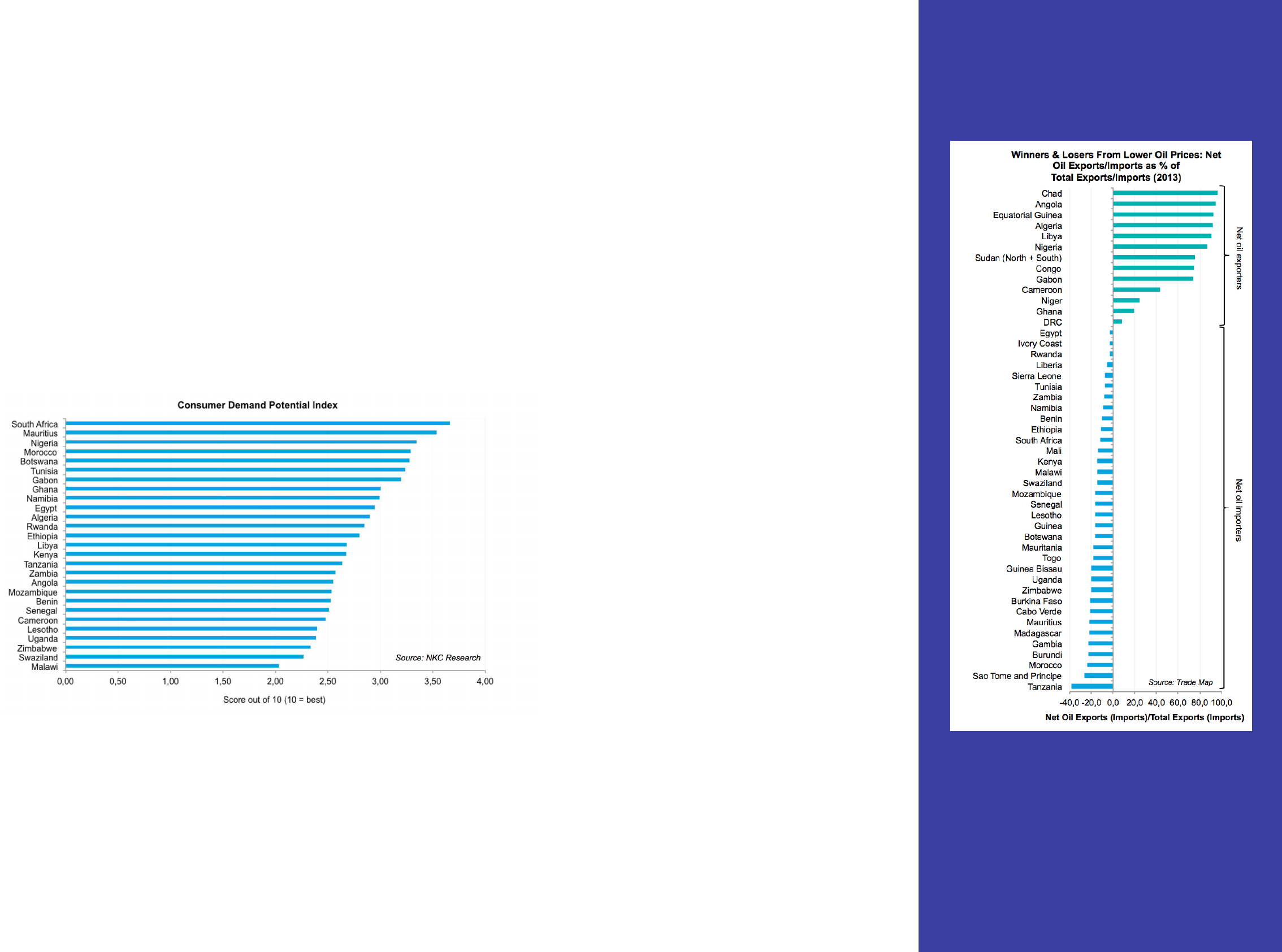
Consumer Demand Potential Index (CDPI)
Combined, the DPI and EIPI aim to identify countries with the
biggest potential growth in consumer demand. This is shown
in the accompanying graph, where the two indices were given
equal weight. As in last year’s report, South Africa, Mauritius
and Nigeria claim the top three positions. These three
countries differ substantially from one another. South Africa
has the most developed retail sector and has a fairly consistent
performance across all sub-indices of the CDPI. Mauritius
has one of the smallest populations on the continent, which
constrains its DPI, but this is counterweighed by its diversified
and well-managed economy and relatively rich population.
In stark contrast, Nigeria offers investors with a very large
potential market, but with risk, as it also has a very challenging
business environment.
In fourth place, and moving up two places since last year, is
Morocco. The country’s demographic make-up is reasonably
favourable, with a young population, rising urbanisation, and
growing middle class.
In addition, a marked improvement in the country’s business
environment is now also making it easier for retailers to enter
the market. The country is also becoming an increasingly
important gateway to Africa for European companies.
Botswana and Tunisia also perform well on the index thanks
to its fairly young and urbanised populations, and solid
business environments. However, both countries (especially
Botswana) have small populations, which reduces their
appeal for retail companies.
Gabon has held on to the seventh position, as the country
has a good demographic profile combined with a high GDP
per capita, which means that there is still a relatively large
consumer market to cater for, despite significant drawbacks.
Although Ghana has significant short-term challenges (large
twin deficits and a depreciating currency), it does quite well in
the CDPI since it is generally welcoming to foreign investors,
has a favourable demographic profile, and has strong
medium-term economic growth potential.
Comparison with the 2014 Index
The countries whose CDPI scores increased
the most over the past year were Egypt and
Benin. Regarding the latter, its score was
boosted by the fact that it was ranked as one of
the top 10 best reformers in the World Bank’s
most recent Doing Business index. Two other
countries worth mentioning are Tanzania and
Mozambique. Although still only ranked 16th and
19th respectively, their rankings are on an upward
trend. These two countries still have extremely
low income levels, with Tanzania’s GDP per capita
at only US$955 and Mozambique’s at US$647.
Therefore, over the short to medium term, retail
will continue to focus on the lower-end of the
income spectrum with FMCG companies being
most prominent. However, both countries have
strong economic growth prospects, and the
development of their natural gas industries holds
exciting long-term prospects due to the additional
foreign exchange and fiscal revenues it will
bring into the country as well as the opportunity
for companies to provide services in the gas-
producing regions.
Three countries’ CDPI scores deteriorated fairly
significantly over the past year, the most severe
of which was Libya, which is in the midst of a
civil war. The other two were Zambia and Ghana.
The deterioration in Zambia’s score was mainly
due to its Doing Business ranking rising from
83rd globally in 2014 to 111th globally in 2015. In
recent weeks, though, there have been signs of
improvement, as the Lungu administration has
reversed some controversial mining laws and we
expect it to follow a more rational and business
friendly approach in its dealings with foreign
investors than the previous regime. Ghana’s score
weakened on almost all the sub-indices, with the
most important contributors to the deterioration
being lower GDP per capita, lower real GDP
growth prospects, an increase in political risk,
and a weaker rating on the Doing Business index.
The core of the problem for Ghana, though, is its
weak fiscal finances, which have contributed to a
widening current account deficit, a depreciating
currency, increasing levels of inflation, high
interest rates, and an increase in tax rates. All
these factors, in addition to ongoing energy
shortages, are likely to keep real GDP growth
under pressure over the short term.
5 | The African Consumer and Retail The African Consumer and Retail | 6
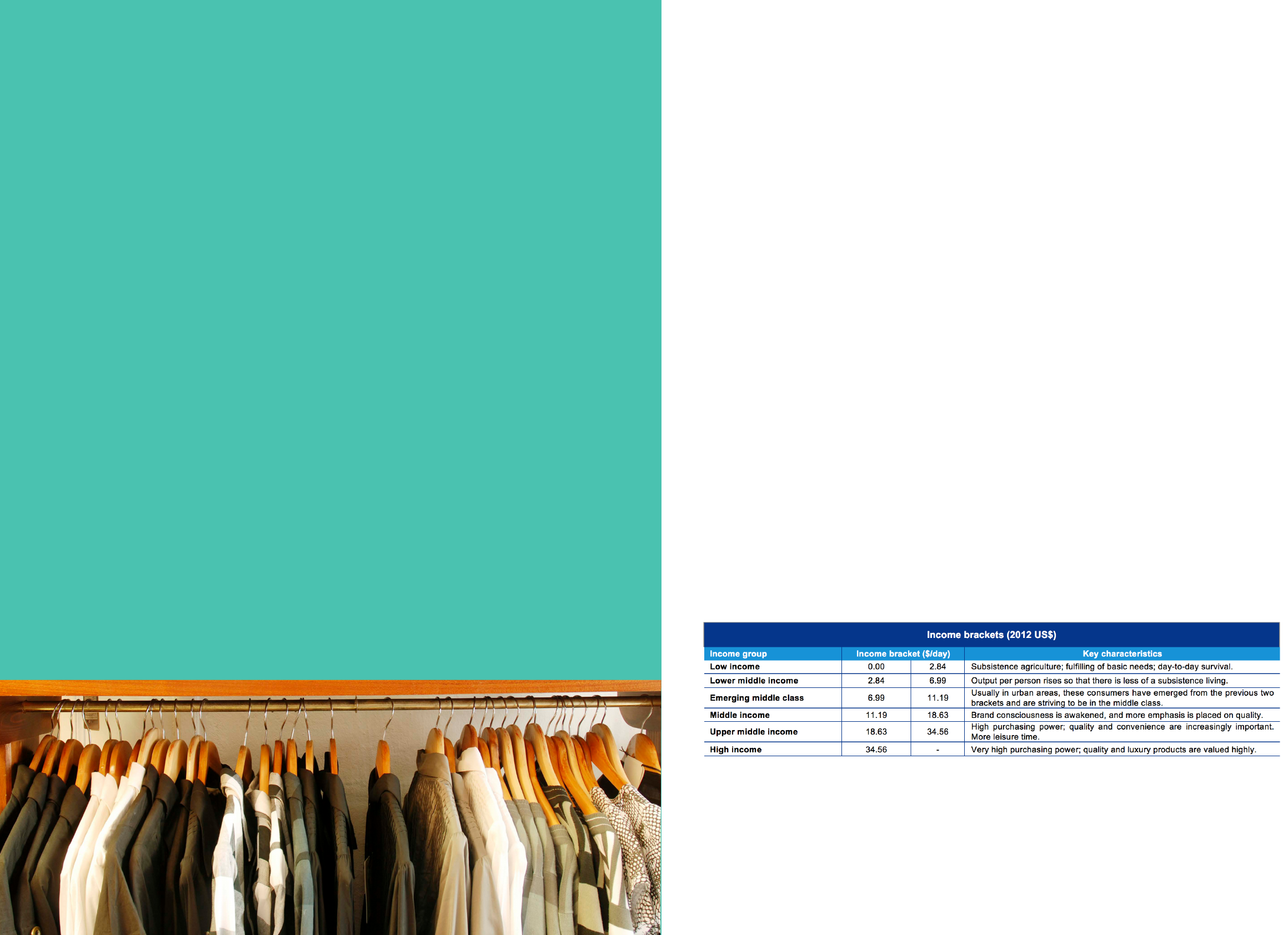
7 | The African Consumer and Retail The African Consumer and Retail | 8
As a continent, Africa is one of the world’s largest net oil
exporters. Therefore, the sharp drop in oil prices since
mid-2014 is expected to have a negative impact on Africa’s
aggregate economic growth prospects. However, it is worth
reiterating that Africa is not one big country; indeed, the
majority of African economies will be benefited greatly from
the drop in oil prices. The accompanying graph illustrates this
by showing the following:
• In the red bars: net hydrocarbon exports (i.e. exports
minus imports) as a percentage of total exports for net oil
exporters; and
• In the grey bars: net hydrocarbon imports (i.e. imports
minus exports) as a percentage of total imports for net oil
importers.
The countries at the top of the chart – those that are most
dependent on oil exports – will be severely negatively
affected by the drop in oil prices. Nigeria, for instance, has
already devalued its currency by more than 20% since the
start of November and pressure on the currency will remain
strong as long as oil prices remain low. In turn, this pushes
up the cost of imports, which hurts consumers’ purchasing
power. Meanwhile, Angolan banks have restricted foreign
exchange transactions due to the lower availability of dollars.
This has made it difficult for foreign companies to repatriate
profits or to import goods. The government has also put
import restrictions on a wide variety of products. This has
already had a negative impact on consumer goods companies
operating in the country, especially those that need to import
their products. In addition, the Angolan government (which
subsidised fuel products) has raised fuel prices by 50% since
the end of 2014 in order to cut subsidies in support of its
budget. In mid-February 2015, the government also slashed
its budget for the year by 35%.
The top nine economies in the graph (up to Gabon) are all
highly dependent on oil, especially their fiscal finances.
Therefore, their governments will be forced to respond to
the drop in oil revenues by reducing fiscal spending, which
could have knock-on effects for employment (especially
in the construction sector if the government cuts public
investment), wages, and subsidies, all of which will affect
consumer spending. (Possible exceptions are Algeria and
Libya, who have exceptionally large stocks of forex reserves,
which they could use to finance spending.) Although
many of these economies will still offer strong long-term
opportunities, it is important to take note of the risks that
emerge when oil prices are low.
As shown in the graph, the vast majority of African countries
are net oil importers and will therefore benefit from the
drop in oil prices. Most notably, consumers will benefit
from a sharp drop in fuel prices, which will increase their
ability to spend on other products. There will also be a
notable decrease in their import bills, which will lead to an
improvement in their current account balances and therefore
the availability of foreign exchange. Morocco, for instance,
struggled with a very large current account deficit in recent
years, largely due to its large oil import bill. As a result of this,
commercial banks struggled with tight liquidity conditions
in recent years, which constrained credit growth. Now with
the current account balance set to improve, banking sector
liquidity should also improve, thereby facilitating lending,
which in turn is expected to boost investment in new and
existing businesses, which would boost employment. With a
few notable exceptions, countries in Southern and East Africa
will tend to benefit the most from the drop in oil prices, while
West Africa will be the hardest hit.
Impact of Lower Oil Prices
INCOMES AND
SPENDING PATTERNS
The African Development Bank (AfDB) estimates that the
size of the African middle class was 350 million people in
2010, or 34% of the population. The AfDB’s definition of the
middle class is daily per capita consumption expenditure
of between US$2 and US$20. However, there is a lot of
criticism against this definition, as it includes people that can
barely make ends meet. After all, the World Bank uses the
US$2/day benchmark as a poverty line. One can hardly be
considered middle class by spending only US$720 a year. The
AfDB acknowledges as much, referring to people spending
between US$2 and US$4 per day as the ‘floating class’ – a
vulnerable group that could easily fall back into poverty.
According to David Cowan, a senior economist for Africa at
Citi, a more realistic definition of middle class in emerging
markets is income of at least US$13.7 per day, which is
enough to allow consumers to purchase durable products.
This is equivalent to around US$5,000 per year.
The following table, which is loosely based on the World
Bank’s classification, provides a breakdown of income
brackets, as well as the key characteristics of these groups.
As we discuss below, most Africans south of the Sahara
are still clustered within the low income grouping. For
these people, the focus is merely on survival. Consumption
decisions therefore centre on the fulfilling of basic needs
and are only made with a short-term outlook. People in this
category usually live a subsistence living, with little left for
savings. As people start to move away from a subsistence
lifestyle, output per person rises, moving them into the lower
middle income group. People in the emerging middle class
have usually migrated to urban areas in search of better job
opportunities. Once people start to earn more money and
move into the middle income group, brand consciousness
is awakened and more emphasis is placed on quality. The
upper middle income group is categorised by very high
purchasing power and increased leisure time. The quality
and convenience offered by products and services become
increasingly important. Finally, people classified in the high
income group have extremely high levels of purchasing
power, and quality, convenience, variety, and luxury are
valued greatly.
Defining the Middle Class
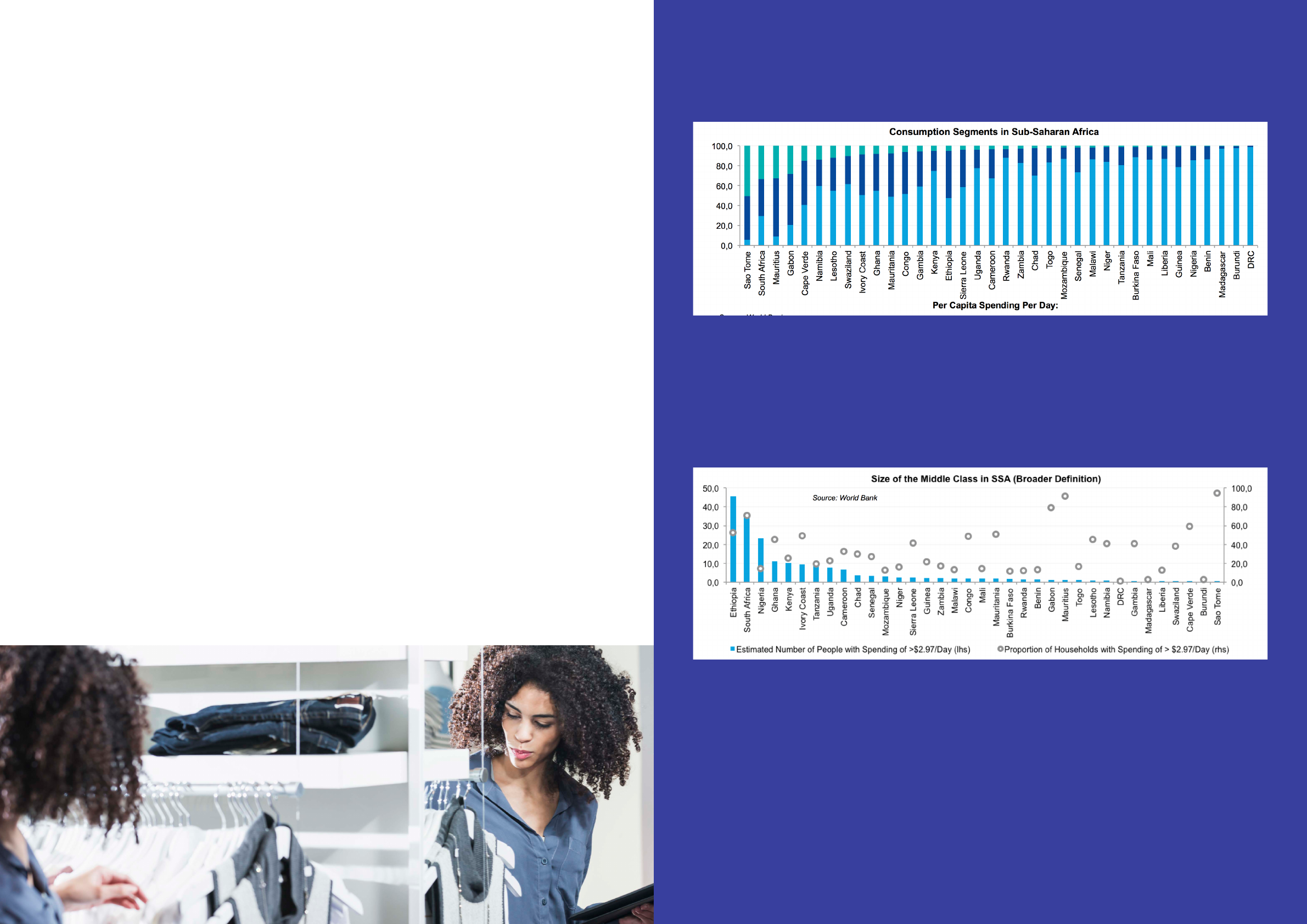
9 | The African Consumer and Retail The African Consumer and Retail | 10
In order to get an idea of the size of the middle class in SSA
countries, each country’s population was multiplied by the
share of households that have per capita spending of above
US$2.97 per day. There are problems with this method.
Notably, the household consumption data are based on
survey data, and the World Bank notes that the sample
sizes, particularly for the higher consumption segments,
“may be very small and not representative”. Nevertheless,
it could still provide valuable insights into the potential
market size of SSA countries. In the first of the two graphs,
a broader view of the middle class is taken, similar to the
one employed by the AfDB study, and all households with
per capita spending of more than US$2.97 per day are
included. This gives a total SSA middle class of 200 million
people, 63% of which live in Ethiopia, South Africa, Nigeria,
Ghana and Kenya.
Spending patterns are determined by disposable income per
capita, in addition to other factors such as tastes, culture,
and idiosyncratic preferences. Despite cultural and regional
factors having an impact on consumer spending patterns
and trends, one generally finds quite a strong positive
relationship between income per person and consumption
per capita for various goods irrespective of these other
factors. This enables the mapping out of a generalised
spending pattern across the income bracket. At the lowest
income bracket, there is very little money (if anything) left
to spend after basic needs have been met. Therefore, at the
bottom of the income bracket, consumption is mainly on
food, much of which has been produced on a small plot of
land rather than purchased. Any excess production is then
bartered or sold in order to pay for other necessities such
as clothing and shelter. As soon as people start producing
more than they consume, funds become available to spend
on more than just the basics. The US$1,000 income level
has been identified as an important barrier that if reached,
allows for an expansion in the amount and type of consumer
products that can be afforded. The first important trend is
an expansion in the amount of food consumed, in order to
boost the daily caloric intake to healthy levels. Following
this, a further increase in income will allow for a switch to
better quality and/or more convenient foods, for example
the gradual introduction of meat and processed food into the
diet. Some of the first non-food products to benefit from the
expansion of annual income beyond the US$1,000 level are
beer, soft drinks, and prepaid mobile phones.
Moving into the emerging middle class allows for further
increases in quantity and quality. For example, consumers
will start shifting from unbranded beers to branded beers –
first to economy brands, and later on, to premium brands.
Eventually, when incomes increase even further, consumers
will start shifting away from beer towards products that are
viewed to be more sophisticated, such as brandy, whisky, and
wine. Even in this consumer bracket, further differentiation
is possible, i.e. from mainstream to premium products. The
same types of shifts occur for other consumer products, e.g.
switching from chicken to red meat or from carbonates to
energy drinks.
Spending Patterns
The first graph in this section shows the breakdown of
households by their per capita spending (based on the World
Bank’s Global Consumption Database). Only a few countries
on the continent have a notable proportion of households that
spend more than US$8.44 per day; in fact, this proportion
is above 10% of all households in only eight countries.
And, of these eight countries, only South Africa has a large
population. Furthermore, in 29 of the 36 countries in this
sample, more than half of all households have spending per
capita of less than US$2.97 per day. In most countries, the
focus for investors will therefore be the FMCG segment,
as most people are not able to afford durable or luxury
goods. That said, even though the proportion of middle- to
high-income groups is generally low, some of the more
populous countries will still have a reasonably large middle
class in absolute terms. In particular, there are bound to be
opportunities in some of the well-off suburbs of the financial
capitals of some countries, including Lagos and Nairobi.
Breakdown of African Income Groups & Estimating the Size of
the Middle Class
The above definition is probably too wide for a middle class,
though, and therefore the number of people that earn more
than US$8.44 per day is also estimated. Based on this
‘narrower definition’ of the middle class, Africa has 36.2
million people in the middle class, 48% of which reside in
South Africa. According to these estimates only five other
SSA countries have more than a million people in the middle
class. These are Ethiopia, Kenya, Ghana, Ivory Coast, and
Uganda. One of the most notable results is that Nigeria’s
middle class is relatively small, at only 803,200 people.
It is possible that the data underestimates Nigeria’s middle
class due to the small sample size; however, the result
stands to reason considering World Bank poverty statistics
that show that around 70% of Nigerians still live on less
than US$1.25 per day.
Although having relatively small middle classes in absolute
terms (400,000 people), there is a relatively large proportion
of middle class people in Gabon (28.2% of households) and
Mauritius (32.5% of households). Mauritius also benefits
significantly from the steady influx of tourists, who are
generally well-off and boost the demand for some products,
such as souvenirs and clothing. As such, developments like
the Bagatelle Mall south of Port Louis, Sunset Boulevard in
Grand Bay and Le Caudan Waterfront in Port Louis continue
to attract a constant flow of people. All countries in the
graph up to Chad have middle classes of more than 300,000
people, thus providing at least some opportunity for retail
companies looking to sell more than just the basic products.

11 | The African Consumer and Retail The African Consumer and Retail | 12
In a survey done by Nielsen in seven African countries,
namely Ethiopia, DRC, Kenya, Nigeria, Tanzania, Uganda, and
Zambia, the affordability of brands was found to be the most
important factor in influencing consumers’ decision to buy,
picked by 37% of respondents. Brand loyalty also plays a big
role, with 31% of respondents saying they always buy the
same brand. (The survey is based on face-to-face interviews
with 5,000 urban and peri-urban residents between the ages
of 15 and 45 across income groups.) Some interesting results
from the survey are listed below:
• Of the seven countries, Ethiopia has the lowest per capita
spending on consumer packaged goods (CPG), Nigeria’s
nominal spending on these products is the largest, while
Tanzania has the largest number of CPG categories with a
penetration rate of higher than 75%.
• Zambia has the lowest TV penetration (67% compared to
an average of 90%), while the DRC has the lowest usage
of print media.
• Kenya has the highest penetration of modern retail
channels.
The fact that Africa’s population is a lot younger than the rest
of the world is an important point for retailers to consider.
According to the UN Population Division, the proportion of
Africans under the age of 25 is projected at around 55.5% in
2015, compared to 37.8% in South America, 36.6% in Asia,
29.1% in Northern America, and 23.9% in Europe. These
young people have significantly different tastes, preferences,
and aspirations than older generations, and this would be
reflected in their demand for different products.
Another important trend to consider is the rise of female
buying power. With more and more women earning their
own money (and with fertility rates declining), this is an
important expanding market for retailers to explore. The
reduction in fertility rates results in an increase in time spent
on other activities, as well as in an increase in the available
discretionary income. With more women having careers,
the importance of convenience with regard to the shopping
experience has also come to the fore, which might help the
development of formal retail in Africa. “The rising middle
class has meant that convenience has become important
for modern time-stripped consumers, with women in Africa
enjoying the mall culture, while wanting instant access to
information and technology and staying connected via
social networking and mobile phone technology”, according
to Daphne Kasriel-Alexander, consumers editor at
Euromonitor International.
Consumer Traits

CHALLENGES
The lack of physical infrastructure has been one of the main
constraints to the entry of formal retailers, as there are simply
not enough shopping centres available at present, while
bureaucratic obstacles and land issues further complicate
matters. For example, according to the UACN Property
Development Company in Nigeria, Lagos had only three
international standard-sized malls (of at least 20,000 m2) as
of October 2013, and could easily hold 20 - 25 malls owing to
its large population.
The ability to source products locally is an important factor
for retailers. Since most African countries lack an established
manufacturing base, they are often forced to source goods
from overseas, which increase their costs (through high
transport costs and import tariffs), while also making
supplies less reliable. To make matters worse, poor transport
infrastructure makes supplies even more unreliable: not
only is road infrastructure very poor across Africa, but there
are often bottlenecks at harbours for imported goods. The
accompanying graph shows the quantity and quality of local
suppliers, based on surveys by the World Economic Forum
(WEF). (The scores in the graph are an average of the ‘local
supplier quantity’ and local supplier quality’ sub-indices of
the WEF’s Global Competitiveness Index). Kenya performs
remarkably well, especially in terms of the quantity of local
suppliers where it is ranked 19th in the world. However,
only five countries in Africa are in the top half of the global
rankings and most African countries score very poorly on
this indicator. Angolan companies in particular seem to have
extreme difficulty sourcing products locally. Prospective
investors therefore have to take exceptional care to secure
reliable suppliers before entering the market across the
continent. Thorough research of the logistical and distribution
channels will also be needed, given the poor quality of
infrastructure.
Another major problem in many African countries are high
import tariffs. Since it is difficult to source local products,
African countries often rely on imports for a wide range of
goods. However, if import tariffs are high, it implies that
retailers need to ask high prices for them to sell goods
profitably. In some instances, this will lead to traders
smuggling goods via informal channels to avoid taxes.
In Maputo, Mozambique, for instance, informal traders
smuggle goods from South Africa, which enables them to
sell their products for up to three times less than formal
retailers, thereby making it difficult for retail companies to
compete with informal traders on imported goods.
Based on the trade freedom category of the Heritage Foundation’s
Index of Economic Freedom, Africa (and SSA in particular) lags the rest
of the world in terms of trade freedom. As can be expected, though,
there are intraregional differences, with Mauritius enjoying a very high
degree of trade freedom (ranked ninth out of 181 countries globally)
and Rwanda performing fairly well (ranked 68th), but most other
countries ranked outside the global top 100. In the accompanying graph
(‘Trading Across Borders’) African countries’ rankings in the Heritage
Foundation’s Trade Freedom and the World Bank’s Trading Across
Borders Indices have been combined.
13 | The African Consumer and Retail The African Consumer and Retail | 17
CHALLENGES
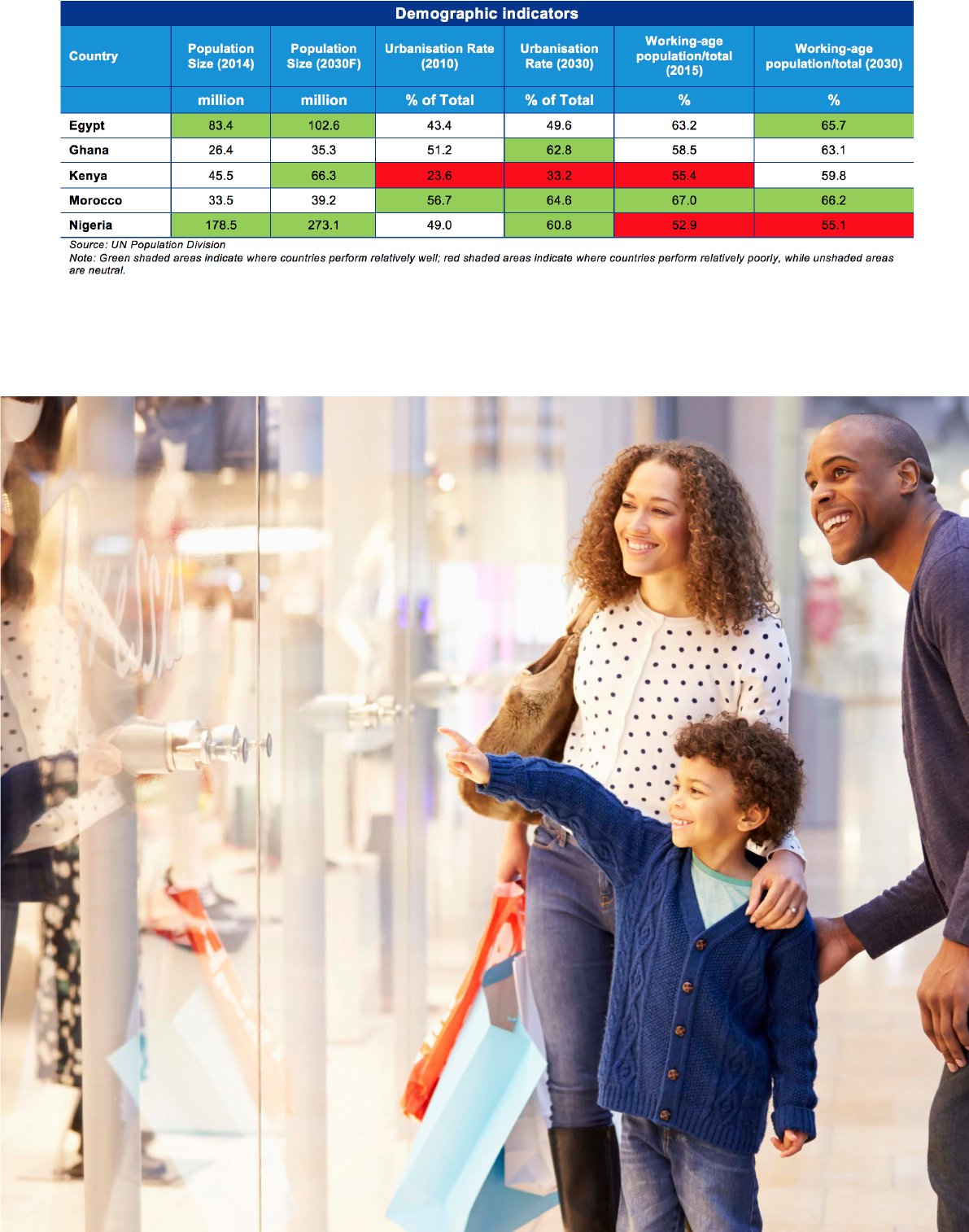
15 | The African Consumer and Retail The African Consumer and Retail | 16
RETAIL MARKETS IN A
SELECTION OF KEY AFRICAN
ECONOMIES
Africa’s retail sector remains relatively under-developed
at present, with most shopping being done at traditional
shops. Much has been said about the prospect for consumer
spending in Africa, driven by demographics and rapid
economic growth. This has fuelled massive interest from
international retailers to establish a footprint on the continent.
Given that many Africans tend to be brand-loyal, it is important
to enter the market at a relatively early stage, in order to have
first-mover advantage and to establish brand loyalty. Five
underlying trends are expected to boost Africa’s retail sector
over the long term, namely:
• Robust economic growth relative to the rest of the world;
• Still-low penetration rates of most consumer goods;
• Saturation levels and lack of further growth in mature
markets;
• The expansion of modern retail outlets, and the general
improvement in infrastructure; and
• A shift in the preferences of African consumers from
informal shopping outlets to modern formal Western-style
retail.
An increasing number of consumers are on the cusp of
the US$1,000 annual income level, which will allow for the
expansion of consumption beyond just the basics. Retailers
will be looking to take advantage of the large market at the
low end, while gradually starting to offer these consumers
higher-value products. In essence, the key strategy for most
retailers focussed on Africa will be to 1) capture the large
low-end market, and 2) benefit from higher margins as these
consumers start trading up, e.g. from unbranded to branded
beer. By establishing brand loyalty at an early stage, consumer
goods companies can benefit from the growth of the African
consumer. This is not to say that there is not potential for the
luxury goods sector as well, although it remains in its infancy at
present in most countries.
Using our demographic and economic potential indices as a
guideline, but also taking other factors into account (including
the current level of formal retail, penetration rates of consumer
goods, the prospect for policy reforms, and the potential for
regional expansion), we have identified five countries that
we believe show the biggest promise for retail development
over the long term. These countries are Egypt, Ghana, Kenya,
Morocco, and Nigeria. Since our 2014 report, Algeria has been
excluded – despite a relatively poor showing in the Consumer
Demand Potential Index, the country was included in the
previous report due to its strong demographic potential, which
implies that if economic policies improve, the retail sector
could truly prosper. However, due to the country’s dependence
on hydrocarbons, the recent drop in oil prices has weakened its
economic prospects. Algeria has therefore been replaced with
Egypt, which has excellent long-term retail prospects due to
its large, young population, and high population density along
the Nile. The economy is also gradually recovering from the
political turmoil of the past four years, with economic growth
subsequently expected to increase.

Traditionally, Egypt is a nation of street retailers, with most
Egyptians shopping in local neighbourhoods and at classic
souks such as Cairo’s Khan el-Khalili. The country’s retail
sector has been struggling since 2011 due to the uprising
and subsequent political turbulence. Furthermore, high
inflation has been the norm in recent years and has eroded
consumer purchasing power, forcing consumers to cut
costs and shop for second hand goods. On the upside,
political stability has returned after the 2014 election,
with the government committed to promoting economic
prosperity. According to Euromonitor, retail (especially in the
grocery industry) saw a slight improvement in 2014 because
consumers tended to prioritise the purchase of essentials
when their incomes were hit hard by inflation.
Western style malls were introduced to the country around
a decade ago with the opening of the Maadi City Centre
and City Stars. More projects such as the Mall of Arabia and
Cairo Festival City followed, but the political upheaval of
recent years slowed further progress. Post-2014 optimism
has seen major retail pioneers, such as Majid Al Futtaim,
announcing that it plans to expand its investments in Egypt
by about E£18bn (US$2.4bn) over the next five years. The
new developments include the 455,500 m2 Mall of Egypt,
which is to be located in Sixth of October City. Mall of Egypt
will be host to 420 stores and will include Ski Egypt, the first
indoor ski slope on the continent of Africa. Other, notable
new mall projects include the expansion of the City Centre
Alexandria by another 12,000 m2.
Despite, the growing optimism toward Egypt as an
investment destination, many malls have vacancy rates
of 25% and higher due to retailers remaining wary of the
country’s political environment.
This phenomenon should abate as longer periods of political
stability are experienced, which would create an opportunity-
rich environment for retailers wishing to set up shop in
future.
As is the case with many of its African peers, e-commerce
is showing great potential in the Egyptian retail market.
Egypt is one of Africa’s most advanced markets in terms
of internet penetration, with internet users numbering half
of the adult population in the country, and still growing.
The major online retailer, Jumia, has recently established is
first retail hub in Giza in order to capitalise on the growing
number on online shoppers in the North African nation.
Outlook – Retailing in Egypt is expected to see a recovery
over the coming years, supported by a wide array of factors.
These include greater political stability, stronger economic
growth and a rising level of disposable incomes. Sales
growth in both the food and non-food retail sectors should
benefit from increased urbanisation, a youthful population
and widening internet access in the North African country.
As investment in Egypt’s formal retail industry improve, so
more people should move towards modern retailing spaces
as opposed to the conventional market or neighbourhood
retailer. Furthermore, according to yStats, online shopper
penetration in Egypt is less than 10% at present, which
means that massive potential exists in this market especially
as the stable political environment persists. Since Egypt
still has around 25.2% of individuals living below the US$2
per day (2011 dollars) poverty line, and due to higher
inflation as well as high unemployment rates, the food and
lower-end of the clothing retail sector will dominate over the
medium term.
Positives: Youthful population; emergent middle class; continued urbanisation
Sectors: FMCG; clothing; luxury goods
Risks: Purchasing power of consumers under pressure at present due to high inflation; threat of terror attacks by jihadist
groups on shopping malls; low economic growth; high unemployment
Egypt
17 | The African Consumer and Retail The African Consumer and Retail | 18
Ghana’s modern retail sector is restricted mainly to Accra, with
some recent activity in Kumasi. In addition, most Ghanaians
still do their weekly shopping at street markets as the middle
class, who typically frequent modern shopping malls, is
still small. Although there are currently only a small number
of international retailers on the scene, the comparatively
accommodative business environment makes the West
African country more attractive as an investment destination.
Ghana was ranked 70th out of 189 countries in the 2015 World
Bank Doing Business survey. Only three countries in Africa
are ranked higher than Ghana: Mauritius (28th), South Africa
(43rd), and Rwanda (46th). It is also less of a problem to source
products in Ghana than it is in some other African countries.
Companies that have set up manufacturing facilities in the
country include Unilever, PZ Cussons, and Denmark’s Fan Milk
Group. Retailers can therefore buy a variety of products locally
rather than import them.
The West Hills Mall (27,000 m2) on the Accra-Cape Coast
Highway, the largest of its kind in Ghana, opened its doors
for business on 30 October 2014. The new development
boasts two anchor tenants, Shoprite and Palace, as well as
63 line shops. The success of this mall, which has a 100%
occupancy rate, has also spurred the developers of the first
phase, Delico Investments, to draw up plans for additions
to the mall, which will add 12,154 m2 of retail space to the
facility. The success of developments such as the West Hills
Mall, Accra Mall (22,900 m2), A&C Square Mall (10,000 m2)
and the Oxford Street Mall (6,230 m2) have prompted further
development plans, with Broll Property Group projecting in
its 2014 annual report that more than 165,000 m2 of formal
retail space will come into operation by the end of 2016. The
rapidly growing demand for shopping options is outpacing
the supply of viable modern shopping spaces in the West
African nation, where retail rents have pushed to levels as
high as US$60/m2, according to Broll property. Other notable
new developments include the Achimota Mall (13,000 m2)
and the Kumasi City Mall (27,000 m2).
A number of South African retailers have expressed a desire
to expand their presence in Ghana, and to take up space in
new developments. These include Shoprite, Game, Foschini,
Mr Price, Spur, Truworths, Woolworths, Edgars, Famous
Brands and Pick and Pay. Well-known international retailers
have been more reluctant to enter the market, although Zara,
Mango, Hugo Boss, Tommy Hilfiger, and TM Lewin have
recently shown interest.
Investors, developers and retailers are also monitoring a
number of key risks such as the depreciating cedi, high
inflation, the recent slowdown in economic growth, the
government’s large fiscal deficit and the erratic electricity
supply. Some of these issues are however being addressed:
most notably, the recent start-up of the Atuabo gas
processing plant will boost Ghana’s electricity-generating
ability and the signing of an economic reform programme
with the IMF will help to reduce the budget deficit over the
medium term, which in turn would also reduce inflation.
This will however take a few years to start having a positive
impact on the Ghanaian economy, with consumers likely
to feel the pinch of a more austere budget (lower wage
increases in particular) in the interim.
Outlook – Formal retail space in Ghana is in short supply on
the back of increased latent demand from consumers, which
has been boosted over the past decade by strong levels of
economic growth, albeit slower in recent months. However,
consumers are currently under pressure due to high levels
of inflation, a rapidly depreciating currency, high commercial
bank interest rates, and higher utility and fuel prices. Private
consumption levels will therefore be negatively impacted
during the coming year, but we remain upbeat about the
long-term potential for the sector, which will be supported
by a growing middle class and a declining population growth
rate. E-commerce should also pick up in Ghana as around
five million (almost 20% of the population) internet users
are currently active. There is massive potential in this
market as stronger future growth prospects should be
accompanied by a higher number of internet users with
greater disposable incomes.
Positives: Opportunity to benefit from first demographic dividend; generally accommodating business environment;
popularity of shopping centres
Sectors: FMCG; clothing; electronics; appliances
Risks: Purchasing power of consumers under pressure at present due to high inflation and depreciating currency; risk of
higher taxes due to the government’s weak finances
Ghana

Kenya has a well-developed retail sector in an African
context, with formal retail market penetration rates at 25%
- 30%, double that of Nigeria. The country boasts a growing
and sizeable emerging middle class with the New World
Wealth report for 2014 reporting that per capita wealth in
Kenya has grown by 89% since 2000. The average value of
a shopper’s basket has risen by 67% in five years, which
makes Kenya the continent’s fastest growing retail market.
BMI estimates that per capita food consumption will increase
by 4.2% p.a. over the 2014-19 period in local currency terms.
In absolute terms, Kenyans are generally still poor, though. In
fact, according to the World Bank, around 45.9% of Kenyans
live on less than US$2 (2005 dollars) a day. As the poor
typically spend a greater portion of their income on food, the
Kenyan retail market is forecast to be dominated by the food
market over the medium term.
The East African nation’s grocery retail market has been
monopolised by local supermarket chains such as Nakamutt
(34 stores), Tuskys (45 stores), Uchumi (22 stores) and
Naivas (29 stores), with foreign chains struggling to make
inroads due to a general resistance to foreign takeovers.
Foreign investors looking to get exposure to Kenya’s retail
play has therefore been limited to purchasing shares in
Uchumi, the only listed Kenyan retailer. Despite this, the
French supermarket giant Carrefour is opening two new
grocery stores in the Kenyan capital, Nairobi, by the end of
2015. Other notable, foreign retail establishments that have
recently made a move on the Kenyan market are the US
brands Domino’s Pizza, Cold Stone Creamery and KFC in
Nairobi and Mombasa.
As in the case of countries such as Nigeria, e-commerce has
also grown significantly in the Kenyan retail and wholesale
market. Kenya is one of the most technologically advanced
nations in Africa when it comes to mobile money payments.
Nearly 26 million Kenyans make use of mobile money, which
represents more than half the adult population. The East
African nation’s openness to new technology has made it
a rich source of business for Amazon-style online shopping
sites like Jumia and Kilimall. The online shopping market will
continue to present a lucrative investment opportunity in
Kenya as the number of mobile internet users will continue to
grow in the near future.
Outlook – Continued strong growth is predicted for Kenya’s
retail sector, supported by an on-going shift to formal retail,
growing levels of urbanisation, and a rising middle class.
Retailers are expected to remain innovative in order to hold
on to market shares. For example, online shopping sites are
creating user incentive schemes to lure a larger number of
clients. The strong expansion of formal financial services
to the previously unbanked in Kenya – through mobile and
agency banking – has opened up an important opportunity
to attract new customers, especially through e-commerce.
Kenyan retailers are expected to increase the range of their
product offerings further over the outlook period in order to
build market share. Further potential also lies in the upper
end of the retail market as the number wealthy Kenyans is
forecast to grow by 73% by 2023, according to the 2014
New World Wealth report. Kenya also has the fourth-highest
number of high-net-worth individuals in Africa.
Positives: Strong population growth; growing middle class; educated labour force; dynamic private sector; regional leader –
possibilities for regional expansion
Sectors: FMCG; clothing; personal care products
Risks: Risk of terror attacks by Al Shabaab; private consumption dependent on agricultural earnings; risk of inflation and higher
taxes; exposure to Europe for export and tourism revenues
Kenya
Morocco is another African nation that shows promise in
the retail sector. New patterns of trade, such as the shift
from traditional grocery retailers to modern super and
hypermarkets, are emerging in the North African country.
Mobile retailing is also on the rise, owing to greater internet
connectivity and a higher number of individuals who have
become banked. Moreover, we estimate that Morocco falls
amongst the top 10 countries in terms of dollar millionaire
growth (26% p.a.) over the 2007-13 period, making its
luxury brand market ripe for the picking.
According to Euromonitor, the Moroccan department of
Trade and Industry implemented the Plan Rawaj (for 2020)
to develop modern retail spaces in a nation where the
modern mall has not been particularly successful. Amongst
the legislative reforms are amendments to a 1955
commercial property law which previously made landlords
reluctant to lease retail space, since tenant eviction was
very difficult. Four new mall developments, under the
auspices of this plan, have occurred since 2011 with the
Carre Eden Mall (27,000 m2) in Marrakech being the most
recent. One of the exciting new retail developments in
Morocco will be the construction of the 540-metre Al-Noor
tower in Casablanca. This 114 storey building, which will
be built by Dubai-based Middle East Development LLC,
will be the tallest building in Africa, housing a seven star
hotel, a business centre and a shopping mall.
The Moroccan grocery retail sector continues to be d
ominated by local players such as Marjane Holdings (33
hypermarkets). The other notable market players in the
grocery arena are Label’Vie , Hyper SA, and Ynna holdings.
National brands typically benefit from their long existence
in Morocco as well as their extensive knowledge of the
North African nation’s retail market. Historically, Moroccan
brands, due to their market experience, have also tailored
their offerings to the purchasing power of social groups
within the country, giving them a competitive edge.
Furthermore, e-commerce is experiencing a boom in the
North African country, with online shopping behemoth,
Jumia, and other internet retail sites such as Hmizate and
Shoppeos having already established themselves in the
market. Much business potential can be unlocked in this
industry since Morocco’s internet usage is high and rising,
according to the Agence Nationale de Reglimentation des
Telecommunications (ANRT). The growth in the North African
country’s e-commerce retail industry could have been even
greater if more attention was paid to Arabic translations of
online retail platforms, greater promotions on social media
occurred and focus was placed on fast growing mobile
device usage.
Outlook – The overall outlook for Morocco’s retail sector
is positive and growth will continue to be supported by a
growing urban middle class. The shift from traditional grocery
retailers to modern hyper and supermarkets will continue
strongly especially as the large grocery chains such as
Label’vie and Marjane continue to open outlets in second
and third tier cities. Moreover, the tourism industry should
contribute to the growth in general retail as tourist arrivals in
Morocco are expected to surpass 11 million per year by 2016.
The upper middle and high earning income groups present
interesting opportunities for retail due to their demand for
brand names and quality products. Speciality retailers
remain a novelty in Morocco and, given the low number of
cars per capita, vehicle retail also presents significant
growth opportunities.
Positives: Rising urbanisation; favourable age structure;
growing middle class
Sectors: FMCG; clothing; vehicles; luxury goods
Risks: Notable exposure to Europe could negatively affect
consumer spending power
Morocco
19 | The African Consumer and Retail The African Consumer and Retail | 20
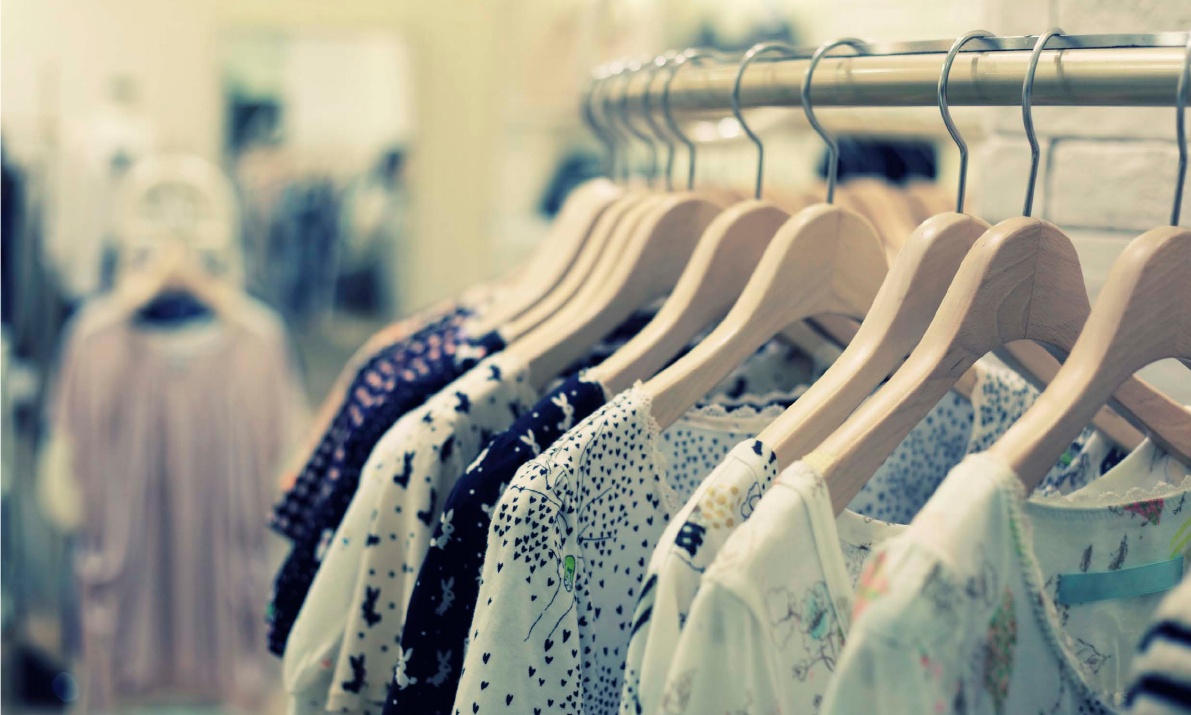
21 | The African Consumer and Retail The African Consumer and Retail | 22
Although Nigeria has experienced high real GDP growth
over the past decade, a large share of the growth in income
has gone to a small, well-connected group (often political
elites) benefiting from oil rents. Consumer goods companies
catering to the lower and middle classes have therefore not
benefited from high oil prices as much as one would have
expected. The recent sharp decline in the international oil
prices is therefore expected to have more of an impact on
the rich than the poor. Still, the recent devaluations of the
naira will increase the cost of imports and thereby weigh on
consumers’ purchasing power. Moreover, tighter monetary
policy due to capital flight and a weaker currency has also
impeded access to credit. These negative trends will abate
over the medium term and should not derail Nigerian
economic prosperity over the long run.
Despite these problems, the Nigerian wholesale and retail
industry (which accounts for 16.4% of GDP) remains a
lucrative investment opportunity on the back of a large and
rising population and an increased rate of urbanisation.
The retail market in the West African country has become
somewhat more sophisticated from its relatively informal
origins prior to 2000. The first modern mall developments in
the country were the Ceddi Mall in Abuja and the Palms Mall
in Lekki, Lagos. The consequent success of these projects
due to the voracious appetite of the up and coming middle
class has led to further developments such as the Palms Polo
Park Mall in Enugu, the Palms Ilorin in Kwara, as well as the
Adeniran Ogunsanya Mall in Surulere and Ikeja City Mall in
Lagos. Retail space in the country has therefore grown from
an initial 30,000 m2 to 227,000 m2.
The geographical spread of malls has increased over
time as well. In 2006, only two Nigerian cities had malls,
whereas there now are 10 cities that have functioning
malls. In addition to Abuja and Lagos, Port Harcourt, Ibadan,
Enugu and Delta now boast modern shopping complexes.
Greenfield Assets Limited and the Abia State government
are currently developing the first purpose built Smart Mall in
the world and the largest mall in Africa in the city of Osisioma
Ngwa. This mall will have an impressive 280,000 m2 retail
space, which roughly translates into 5,830 shops. In addition,
the development will comprise a games arcade, petrol
stations, climate-controlled warehouse and state of the
art cinemas.
The initial retail landscape was dominated by Nigerian and
South African firms. Amongst the major South African players
in the West African nation are Game, Nandos, Shoprite, Mr
Price, Foschini and Barcelos. Recently, the country has also
seen an influx of Middle Eastern, American and European
brands such as Swatch. Brand diversity remains limited in
many of the newly-developed malls and holds great potential
for new business ventures in Africa’s largest and most
populous economy.
Nigeria has also seen the development of a market for luxury
goods. The country’s burgeoning middle class is expected
to have consumer spending in excess of US$25bn by 2020.
This is comparable to spending in Mumbai, India’s largest
business hub. Furthermore, the West African nation’s
demand for champagne is expected to more than double
between 2011 and 2016. Nigeria is also the world’s fastest
growing aviation market, with 70 new private jets projected
to be delivered in the country over the next four years.
However, according to the World Bank, in 2010 about 46%
of Nigerians lived on US$2 or less a day (at 2010 international
prices). These stark contrasts further give credence to the
fact that the Nigerian retail and wholesale market is
highly polarised.
The e-commerce trend also shows no abatement. Major
internet sites such as Jumia and Konga have done well in the
fashion and mobile devices markets, whereas Supermart.ng
and Gloo.ng have made inroads in the order and delivery of
supermarket goods. According to Disrupt Africa, the Gloo.ng
site had around 7,000 users per month at the start of 2015,
up 800% y-o-y. The formal supermarket landscape remains
highly fragmented as a population of 180 million people are
serviced by only two supermarket chains with 15 outlets
countrywide. Should the problems in infrastructure and the
difficult business environment receive more attention from
Nigerian authorities, both the off and online grocery shopping
markets have massive investor potential.
Positives: Large market size; youthful population; urbanisation; privatisation of power sector
Sectors: FMCG; clothing; luxury goods
Risks: Risk of naira devaluation, which would raise cost of imported goods; poor infrastructure; difficulty
to source products due to small local manufacturing sector; political risk; security risks in northern states
Nigeria
Despite the wealth of opportunities in the Nigerian retail
and wholesale market, certain challenges in the business
environment make investment difficult. The West African
nation is dominated by both high financing costs and very
high construction prices. Infrastructure gaps also inhibit
the development of effective retail supply chains. Security
concerns like the rising insurgency trend especially in the
north, also have a major disruptive impact on the business
environment. International investors also seem to have
misconceived notions about Nigeria such as the absence of a
market for luxury goods.
Outlook – The Nigerian consumer may well be under
pressure over the next few years as low oil prices put
pressure on the Naira and government infrastructure
spending plans. However, the retail sector remains an
attractive prospect over the longer term. Informal retail
channels will continue to dominate. This is despite some
specific measures being implemented by State governments
to encourage the formalisation of the sector. The share of
modern retail is however expected to continue increasing
over the coming years, driven by the development of a
number of large-scale modern shopping centres. The
low-income consumer by far dominates the Nigerian retail
scene, which will provide a lot of opportunities for FMCG
companies. In addition, online grocery shopping is becoming
ever more popular due to the limited access to formal grocery
supermarkets. Brand diversification will also present a good
investment opportunity in the future as average household
incomes grow. Despite Nigeria’s rich investment potential,
some serious challenges for retailers to set up shop persist.
If the country’s infrastructure deficiencies and cumbersome
legislative hurdles are not addressed in the near future,
the cost of establishment for international brands may
remain too high.

SOURCES OF INFORMATION
Actis
African Development Bank
Citi Group
Disrupt Africa
Economist Intelligence Unit
Euromonitor International
Financial Times
Food and Agriculture Organisation
Heritage Foundation
How we made it in Africa
International Monetary Fund
NKC African Economics
Oxford Business Group
Trade Map
UACN Property Development
UN Population Division
World Bank
World Economic Forum
World Wealth Report
yStats
The African Consumer and Retail | 24

CONTACT DETAILS
© 2016 KPMG Africa Limited, a Cayman Islands company and a member firm of the KPMG
network of independent member firms affiliated with KPMG International Cooperative (“KPMG
International”), a Swiss entity. All rights reserved. The KPMG name, logo and “cutting through
complexity” are registered trademarks or trademarks of KPMG International. MC14857.
kpmg.com/social media
kpmg.com/app
Seyi Bickersteth
Chairman KPMG Africa
T: +23412805984
E: seyi.bickersteth@ng.kpmg.com
Bryan Leith
COO KPMG Africa
T: +27116476245
E: bryan.leith@kpmg.co.za
Benson Mwesigwa
Africa High Growth Markets
KPMG Africa
T: +27609621364
E: benson.mwesigwa@kpmg.co.za
Molabowale Adeyemo
Africa High Growth Markets
KPMG Africa
T: +27714417378
E: molabowale.adeyemo@kpmg.co.za
Wole Obayomi
Partner, Consumer markets
West Africa
T: +23412718932
E: wole.oba[email protected].com
Dean Wallace
Partner, Consumer markets
South Africa
T: +27116476960
Mohsin Begg
Manager, Consumer markets
South Africa
T: + 27827186841
Jacob Gathecha
Partner, Consumer markets
East Africa
T: +254202806000
E: jgathec[email protected]
Fernando Mascarenhas
Partner, Consumer markets
Angola
T: +244227280102
E: femascarenhas@kpmg.com
KPMG Africa
